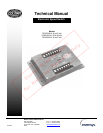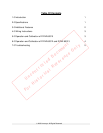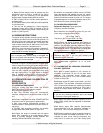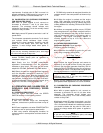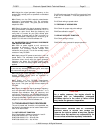
F-23371 Electronic Speed Switch Technical Manual Page 5
2002 Invensys. All Rights Reserved
6.3.3 Adjust the signal generator frequency to the
desired SW1 set/trip point as specified or calculated
in step 6.2.1.
6.3.4 Slowly turn the SW1 setpoint potentiometer
adjustment counterclockwise until the ohmmeter
indicates an open circuit. This gives you the correct
setpoint for SW1.
6.3.5 Slowly increase the signal generator frequency
until the ohmmeter connected to terminals 10 to 12
indicates an open circuit. Note the frequency and
verify that it is correct for your SW1 set/trip point
requirements. If set/trip point of SW1 is correct it is
properly calibrated. If set/trip point is incorrect, go to
step 6.2.3, 6.3.3 and 6.3.4 and calibrate unit.
6.4 CALIBRATION OR CHECKING PROCEDURE
FOR OS-SW2 TRIP POINT
6.4.1 With no power applied to unit, connect an
ohmmeter to terminals 7 and 9 (no other wires
attached). The ohmmeter should indicate zero
resistance (short circuit). This is the normally closed
contact on relay OS-SW2.
6.4.2 Apply correct DC power to terminals 1 and 2 of
speed switch. The ohmmeter should indicate zero
resistance (short circuit) with the signal generator
frequency set below the OS-SW2 set/trip point;
therefore, it must not change states when power is
applied.
6.4.3 Adjust the signal generator frequency to the
desired OSSW2 set/trip point as specified or
calculated in step 6.2.1.
6.4.4 Slowly turn the OS-SW2 potentiometer
counterclockwise until the ohmmeter indicates an
open circuit. This gives you the correct setpoint for
OS-SW2.
6.4.5 Slowly increase the signal generator frequency
until the ohmmeter connected to terminals 7 to 9
indicates zero resistance. Note the frequency and
verify that it is correct for your OS-SW2 set/trip point
requirements. If set/trip point of OS-SW2 is correct, it
is properly calibrated. If set/trip point is incorrect, go to
step 6.2.3, 6.4.3 and 6.4.4 and calibrate unit.
7.0 TROUBLESHOOTING PROCEDURE
The unit is potted and, therefore, non-repairable, but
the following checkpoints can be used to determine if
there is an internal fault.
7.1 UNIT DOES NOT FUNCTION
7.1.1 Check battery voltage on terminals 1 and 2.
DYNZ-60010-000-0-40 — 8 to 40 Vdc
DYNZ-60012-000-0-74 — 58 to 88 Vdc
DYNZ-60013-000-0-40 — 8 to 40 Vdc
7.1.2 Check input signal from MPU on terminals 5 and
6 with an AC voltmeter — must be greater than 0.7
volts rms.
7.1.3 Check wiring to speed switch.
7.2 TRIPPING AT WRONG RPM
7.2.1 Check for proper trip point settings.
7.2.2 See calibration section.
7.3 RELAY DOES NOT FUNCTION
7.3.1 Check wiring to relays.
7.3.2 Check relay contacts for proper operation.
–
CAUTION
–
As a safety measure, the engine should be
equipped with an independent overspeed
shutdown dev
ice in the event of failure which
may render the governor inoperative.
-
NOTE
-
Barber-
Colman believes that all information
provided herein is correct and reliable but
reserves the right to update at any time. Barber
-
Colman does not assume any responsibi
lity for
its use unless otherwise expressly undertaken.
NOTE
If you are only checking calibration point, omit steps
6.4.3 and 6.4.4 and go to step 6.4.5.
Uncontrolled Document
For Historical Reference Only



